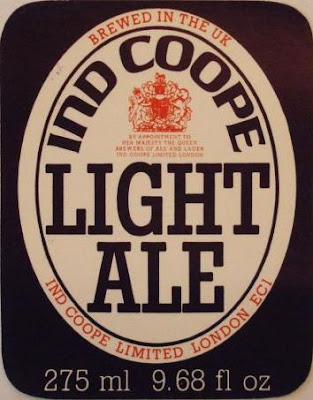It’s nice to have so many analyses of Double Diamond. And that also tells me something else: if Whitbread were so interested in it, it must have been a serious player. With a gravity in the high 1040’s, it was definitely in the class of premium Pale Ale. The sort of slot Whitbread White Shield, Bass Red Triangle and Truman’s Ben Truman fell into.
It’s interesting that the gravity went up a few points in 1950, possibly in response to a tax cut that year (from 218s 4d to 198s 5d per standard barrel). Tax went up and down a little in the 1950’s, but hovered around 200s per standard barrel. How odd then that at the same time as there was a fairly substantial cut in tax in 1960 (from 200s 9d to 157s 11d), the gravity of Double Diamond was slashed, but the price remained about the same.
If you look at the price compared to OG, you can also see that they were charging a premium for Double Diamond. It varies between 0.57 and 0.78d per gravity point, while sparkling Ale is mostly 0.50 to 0.57d. As it was heavily advertised, I guess that’s what you’d expect.
Moving on, it looks like Sparkling Ale was renamed Light Ale in the mid-1950’s. I suspect this reflects common usage. There were a variety of names for this type of beer before WW II: Dinner Ale, Light Dinner Ale, Light Sparkling Ale and many more. My guess is that the punters simply asked for Light Ale, no matter what the brewery whose pub they were in stuck on the label. At around 3% ABV, it’s pretty typical of a 1950’s Light Ale.
| Ind Coope bottled Pale Ales 1948 - 1960 | |||||||||
| Date | Beer | Style | Price per pint d | Acidity | OG | FG | ABV | App. Atten-uation | colour |
| 1952 | Coronet Pale Ale | Pale Ale | 22 | 0.05 | 1035.6 | 1008.6 | 3.50 | 75.84% | 22 B |
| 1948 | Double Diamond | Pale Ale | 26 | 0.05 | 1045.2 | 1009.4 | 4.48 | 79.20% | 18 B |
| 1950 | Double Diamond | Pale Ale | 0.06 | 1045.2 | 1011.2 | 4.42 | 75.22% | 21 B | |
| 1950 | Double Diamond | Pale Ale | 0.05 | 1047.9 | 1012.3 | 4.62 | 74.32% | 19.5 B | |
| 1950 | Double Diamond | Pale Ale | 29 | 0.05 | 1048.3 | 1010.9 | 4.86 | 77.43% | 21 B |
| 1951 | Double Diamond | Pale Ale | 29 | 0.06 | 1047.7 | 1010 | 4.91 | 79.04% | 25 |
| 1953 | Double Diamond | Pale Ale | 33 | 0.05 | 1048.7 | 1009.7 | 5.08 | 80.08% | 23.5 |
| 1955 | Double Diamond | Pale Ale | 32 | 0.04 | 1048.5 | 1012.7 | 4.65 | 73.81% | 19 |
| 1956 | Double Diamond | Pale Ale | 34 | 0.04 | 1048.3 | 1012.7 | 4.62 | 73.71% | 20 |
| 1956 | Double Diamond | Pale Ale | 34 | 0.04 | 1047.9 | 1014.1 | 4.38 | 70.56% | 19 |
| 1959 | Double Diamond | Pale Ale | 32 | 0.04 | 1047.5 | 1011.9 | 4.62 | 74.95% | 20 |
| 1960 | Double Diamond | Pale Ale | 30 | 0.04 | 1038.4 | 1012.4 | 3.36 | 67.71% | 18 |
| 1950 | John Bull Ale | Pale Ale | 0.05 | 1042.5 | 1012.2 | 3.93 | 71.29% | 40 + 13 | |
| 1954 | John Bull Ale | Pale Ale | 30 | 0.04 | 1048.1 | 1014.8 | 4.31 | 69.23% | 115 |
| 1956 | Light Ale | Pale Ale | 20 | 0.04 | 1031 | 1010.5 | 2.65 | 66.13% | 22 |
| 1959 | Light Ale | Pale Ale | 20 | 0.02 | 1031.5 | 1009.8 | 2.81 | 68.89% | 20 |
| 1950 | Sparkling Ale | Pale Ale | 0.06 | 1029.7 | 1007 | 2.94 | 76.43% | 24 B | |
| 1950 | Sparkling Ale | Pale Ale | 15 | 0.06 | 1029.7 | 1007.4 | 2.89 | 75.08% | 25 B |
| 1950 | Sparkling Ale | Pale Ale | 18 | 0.03 | 1033.3 | 1007.7 | 3.32 | 76.88% | 22 B |
| 1951 | Sparkling Ale | Pale Ale | 18 | 0.05 | 1032.1 | 1008 | 3.12 | 75.08% | 25.5 |
| 1951 | Sparkling Ale | Pale Ale | 18 | 0.05 | 1032.6 | 1007.6 | 3.24 | 76.69% | 21 |
| 1954 | Sparkling Ale | Pale Ale | 24 | 0.04 | 1030.5 | 1008.5 | 2.85 | 72.13% | 26 |
| Source: | |||||||||
| Whitbread Gravity book held at the London Metropolitan Archives, document number LMA/4453/D/02/002. | |||||||||
Looking at the numbers, I wonder if I’ve got John Bull classified correctly. It’s quite a dark brown in colour, darker than most Milds. Was it really Double Diamond coloured up with caramel? Brewers loved doing that sort of thing.
I’ll be finishing off Ind Coope’s bottled beers next time. Before moving on to the draught beers.












































































No comments:
Post a Comment